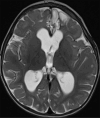Clipping of a ruptured cerebral aneurysm in a toddler: a case report and review of aneurysmal treatment in children
- PMID: 39524384
- PMCID: PMC11543122
- DOI: 10.21037/tp-24-289
Clipping of a ruptured cerebral aneurysm in a toddler: a case report and review of aneurysmal treatment in children
Abstract
Background: Pediatric intracranial aneurysms account for 5% of all aneurysms and less than 10% of all aneurysms cause non-traumatic intracranial hemorrhage in children. They are most commonly secondary to trauma, infection, or genetic etiologies; however, case reports have described iatrogenic intracranial aneurysms. We describe a case of a ruptured aneurysm with an associated intracranial hematoma that was treated by surgical clipping and clot evacuation.
Case description: The patient was a 15-month-old boy without a history of trauma or infection, who developed acute-onset nausea and subsequent neurological deterioration and status epilepticus. Imaging demonstrated a 13-mm saccular anterior cerebral artery aneurysm with accompanying large left frontal intraparenchymal hematoma and intraventricular hemorrhage. He was treated with urgent craniotomy for surgical clipping and clot evacuation. An external ventricular drain was placed to treat the hydrocephalus. The patient subsequently received a ventriculoperitoneal shunt with rehabilitation disposition. There was a family history of intracranial aneurysms and cavernous malformations; however, genetic testing was negative. One year later, he is developing his speech and has ambulated independently.
Conclusions: We highlight the importance of expeditious care in toddlers with rapidly deteriorating neurological examination results and associated intracranial findings. We demonstrate the rarity of intracranial aneurysms in a toddler and the need for further study on this topic, as there is no clear etiology for this finding in this patient.
Keywords: Cerebral aneurysm; case report; cerebrovascular; neurosurgery.
2024 AME Publishing Company. All rights reserved.
Conflict of interest statement
Conflicts of Interest: All authors have completed the ICMJE uniform disclosure form (available at https://tp.amegroups.com/article/view/10.21037/tp-24-289/coif). The authors have no conflicts of interest to declare.
Figures





Similar articles
-
Coil embolization for intracranial aneurysms: an evidence-based analysis.Ont Health Technol Assess Ser. 2006;6(1):1-114. Epub 2006 Jan 1. Ont Health Technol Assess Ser. 2006. PMID: 23074479 Free PMC article.
-
Surgical management of ruptured middle cerebral artery aneurysms with large intraparenchymal or sylvian fissure hematomas.Neurosurgery. 2015 Mar;76(3):258-64; discussion 264. doi: 10.1227/NEU.0000000000000596. Neurosurgery. 2015. PMID: 25603109
-
Aneurysm location and clipping versus coiling for development of secondary normal-pressure hydrocephalus after aneurysmal subarachnoid hemorrhage: Japanese Stroke DataBank.J Neurosurg. 2015 Dec;123(6):1555-61. doi: 10.3171/2015.1.JNS142761. Epub 2015 Jul 31. J Neurosurg. 2015. PMID: 26230474
-
[Ruptured traumatic aneurysms of the peripheral anterior cerebral artery: study of delayed hemorrhage after closed head injury].No Shinkei Geka. 1997 Apr;25(4):337-44. No Shinkei Geka. 1997. PMID: 9125717 Review. Japanese.
-
Combined surgery and embolization to treat ruptured cerebral aneurysms with cerebral hematoma and intracranial hypertension: a retrospective analysis and review of the literature.Radiologia (Engl Ed). 2019 Jan-Feb;61(1):42-50. doi: 10.1016/j.rx.2018.09.003. Epub 2018 Nov 3. Radiologia (Engl Ed). 2019. PMID: 30396604 Review. English, Spanish.
Cited by
-
Embolization of an anterior communicating aneurysm with a Woven EndoBridge combined with a coil: a case report.Am J Transl Res. 2025 Mar 15;17(3):2233-2239. doi: 10.62347/LIKZ9657. eCollection 2025. Am J Transl Res. 2025. PMID: 40225992 Free PMC article.
References
Publication types
LinkOut - more resources
Full Text Sources
